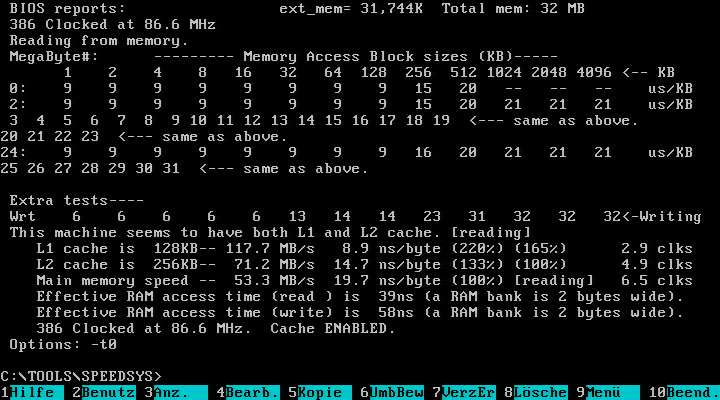FGB wrote:Speedsys CPU scores are not accurate. F.e. a 386 without FPU scores significantly higher than a 386 with a FPU installed. The same occurs here: The NexGen has no FPU, hence the unusual high CPU score.
I would use other programs to measure the ALU performance, NSSI for example.

About the Waitstates. It is not as critical as thought. Primarily it is important that the graphics card can keep up at all, so e.g. the ET4000 shows that the 32 bit Read Transfer Rate is 2x the 16 bit one, while e.g. the S3 or Trident don't. This means the graphics card can keep up at 32 bit. However the ET4000 does not work stable with 1 WS and at 2 WS it is even with the Avance Logic ALG2228. Mainboard VLB is 0 WS.
So with each additional WS the performance in 3DBench goes down by 2.2 fps (at 65.3 fps max.).
So in this scenario the S3 86C805 is faster at 1 WS in 8 bit transfers than the ET4000 with 2 WS with 8 bit transfers. However if the software uses 32 bit transfers then the S3 can't keep up.
(BTW thats also the main behaviour in phils vga benchmark, as 3DBench2 shows 8 bit speed, while pcplayer bench uses 32 bit transfers).
Numbers: (System is the NexGen at 42 MHz VLB)
ET4000W32i (VESA 1.0)
3DBench2
1 WS 65.3
2 WS 63.1
3 WS 60.8
4 WS 58.7
1 WS:
PCP VGA 17.5
PCP 101 ? (no VESA 1.2)
VIDSPEED 320x200x256
width write read
8 3719 1810
16 7440 3588
32 14881 7034
VIDSPEED 640x480x256 VESA banked
width write read
8 3719 1809
16 7438 3586
32 14882 7023
2 WS:
PCP VGA 17.4
VIDSPEED 320x200x256
width write read
8 3409 1810
16 6818 3587
32 13641 7031
VIDSPEED 640x480x256 VESA banked
width write read
8 3409 1809
16 6818 3584
32 13636 7020
ALG2228
3DBench2
50 MHz 60.8 -> 3 WS
33/40 MHz 63.1 -> 2 WS
2 WS:
PCP VGA 17.4
PCP 101 6.5
VIDSPEED 320x200x256
width write read
8 3409 1554
16 6818 3108
32 13641 6217
VIDSPEED 640x480x256 VESA banked
width write read
8 3409 1524
16 6818 3049
32 13636 6101
S3 86C805
3DBench2
65.6 -> 1 WS?
PCP VGA 16.6
PCP 101 5.9
VIDSPEED 320x200x256
width write read
8 3719 1364
16 7440 2728
32 8614 3614
VIDSPEED 640x480x256 VESA banked
width write read
8 2044 1406
16 4087 2812
32 8174 5624
SPEA VEGA CL-GD5424
60.8 -> 3 WS
PCP VGA 16.5
PCP 101 5.9
VIDSPEED 320x200x256
width write read
8 3147 1521
16 6294 3043
32 8183 4051
VIDSPEED 640x480x256 VESA banked
width write read
8 3146 1509
16 6293 3018
32 8182 4019
Trident TGUI9400CXI
O/C
?/? NI/I ?/+APS ?/FAST CLK ?/?
J1 J8 J7 J10 JX7
1-2 C O O C
3DBench2 52.8
PCP VGA 15.8
PCP 101 6.1
VIDSPEED 320x200x256
width write read
8 2383 1051
16 4768 2103
32 6059 2797
VIDSPEED 640x480x256 VESA banked
width write read
8 2406 1498
16 4812 2997
32 9628 5994



